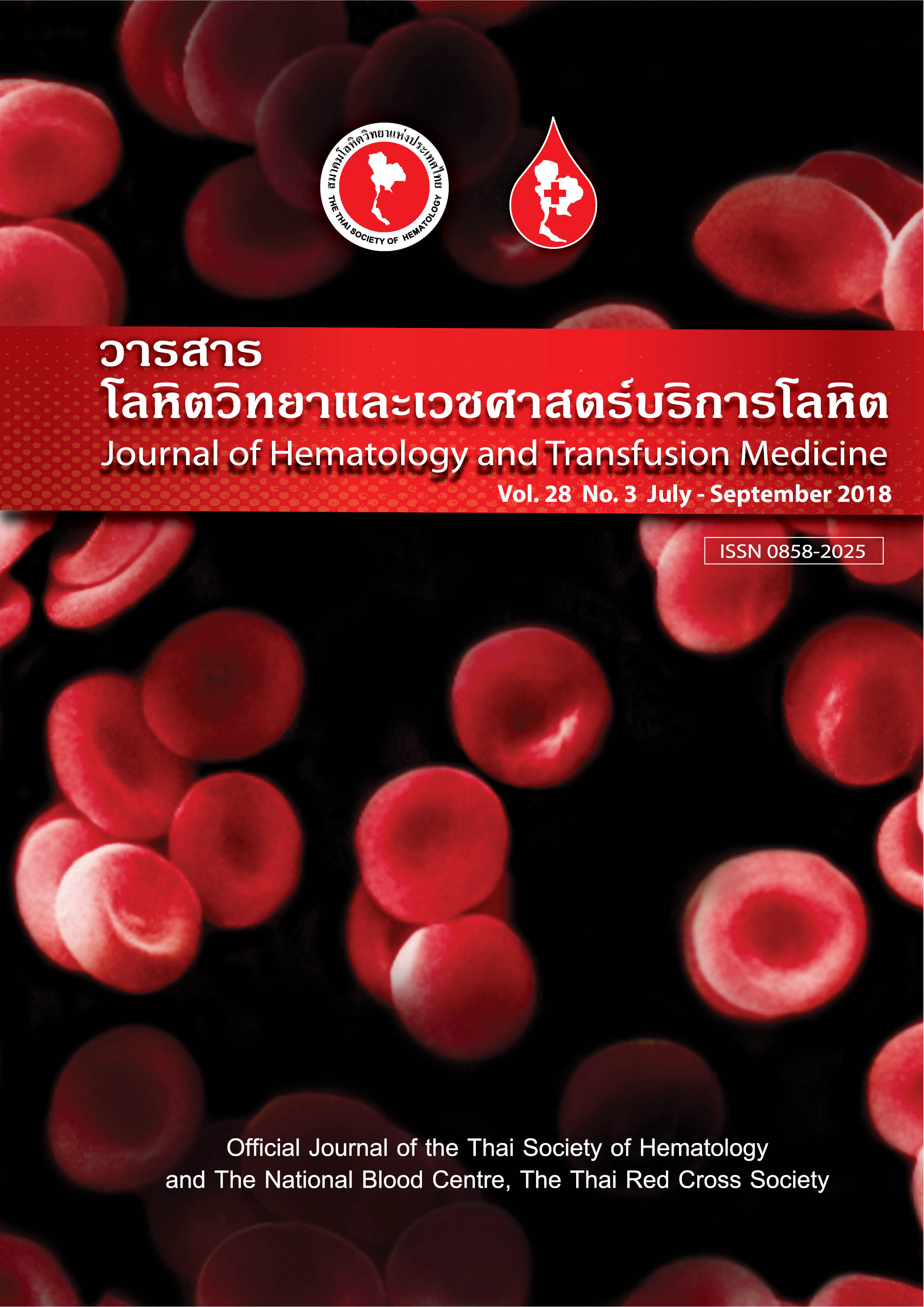การประเมินการทดสอบความเข้ากันได้ด้วยวิธีโฟลไซโตเมทรีสามสีสำหรับการปลูกถ่ายไตจากผู้บริจาคที่มีชีวิต
คำสำคัญ:
Flow cytometric crossmatch, Kidney transplantation, Living-relatedบทคัดย่อ
บทคัดย่อ
บทนำ การทดสอบความเข้ากันได้ด้วยวิธีโฟลไซโตเมทรีสามสีเป็นการทดสอบโดยใช้เซลล์เพื่อหาแอนติบอดีที่จำเพาะกับผู้บริจาคในผู้ป่วยเตรียมรับการปลูกถ่ายอวัยวะ การประเมินความถูกต้องและความสามารถในการใช้งานก่อนนำมาใช้ในงานประจำเป็นสิ่งที่จำเป็น วัตถุประสงค์ เพื่อพัฒนาวิธีการในการทดสอบและประเมินความถูกต้องและความสามารถในการใช้งานของการทดสอบความเข้ากันได้ด้วยวิธีโฟลไซโตเมทรีสามสีเพื่อการปลูกถ่ายไตจากผู้บริจาคที่มีชีวิต วัสดุและวิธีการ หาค่าจุดตัดในการแปลผลโดยทดสอบซีรัมควบคุมผลลบและซีรัมควบคุมผลบวกกับเซลล์ของผู้บริจาคเลือดจำนวน 30 ราย ประเมินความถูกต้องโดยทดสอบซีรัมที่มีความจำเพาะกับแอนติเจนของผู้บริจาคเลือดจำนวน 18 ราย เปรียบเทียบความสามารถในการใช้งานของการทดสอบความเข้ากันได้ด้วยวิธีโฟลไซโตเมทรีโดยการย้อมทีและบีเซลล์สามสีและสองสีในผู้ป่วยที่จะได้รับการผ่าตัดปลูกถ่ายไตจากผู้บริจาคที่มีชีวิต ผลการศึกษา ในการทดสอบความเข้ากันได้ด้วยวิธีโฟลไซโตเมทรีสามสีพบว่าค่าจุดตัดในการแปลผลคือ ผลการทดสอบที่ค่ามัธยฐานของการติดสีที่เบี่ยงเบนไปมากกว่าค่าของซีรัมควบคุมผลลบ จำนวน 22.46 ช่องสำหรับการทดสอบทีเซลล์และมากกว่า 52.78 ช่องสำหรับการทดสอบบีเซลล์ การประเมินความถูกต้องพบว่าการทดสอบความเข้ากันได้ด้วยวิธีโฟลไซโตเมทรีสามสีให้ผลบวกกับซีรั่มที่มีความจำเพาะกับแอนติเจนของผู้บริจาคเลือดทั้ง 18 ราย ผลการทดสอบความเข้ากันได้ด้วยวิธีโฟลไซโตเมทรีสามสีสัมพันธ์ไปกับผลการทดสอบความเข้ากันได้ด้วยวิธีโฟลไซโตเมทรีสองสี (การทดสอบทีเซลล์ p< 0.05 และการทดสอบบีเซลล์ p< 0.05) โดยใช้เซลล์น้อยกว่า (1 x106 เซลล์กับ 4 x106 เซลล์) หลอดทดลองน้อยกว่า (5 หลอดกับ 8 หลอด) และเวลาน้อยกว่า (250 นาทีกับ 360 นาที) สรุป การทดสอบความเข้ากันได้ด้วยวิธีโฟลไซโตเมทรีสามสีที่พัฒนาขึ้นให้ผลการทดสอบสัมพันธ์ไปกับผลการทดสอบความเข้ากันได้ด้วยวิธีโฟลไซโตเมทรีสองสี โดยลดเวลาและแรงงานในการทำการทดสอบ



